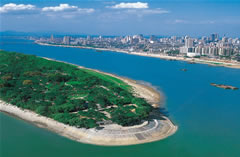|

Changsha city is the capital of Hunan Province, as well as the center of the province in terms of politics, economy, culture, education, transportation, communication, finance, business and information. Under its jurisdiction are one city, three counties and five districts. They are Liuyang City, Changsha County, Wangcheng County, Ningxiang County and north, south, west, east and suburb districts. Changsha City lies in the northeast of Hunan Province, at the lower reaches of the Xiangjiang River. The Xiangjiang River runs from its north to south. North of the Dongting Lake and south to Hengshan Mountain, it was once called the lips of Hunan and Hubei, the throat of Guizhou and Guangdong. Changsha is a beautiful city in South China with many hills, rivers, lakes, pains, lakes and cities.
History
The site has a 3,000-year history of occupation, and was an important center of the southern Chu State culture in the Warring States period (5th-3rd c. BC). The lacquerware and silk textiles recovered from a Western Han (2nd century BC) tomb at Changsha are an indication of the richness of local craft traditions. In 1904 Changsha was opened to foreign trade, and large numbers of Europeans and Americans settled there. Mao Zedong was born in nearby Shaoshan, and he studied and taught at Changsha.
Changsha has a long history of civilization and a splendid ancient culture. There are many ancient tombs and relics here. Having a lot of talents and heroes, Changsha was called the Cradle of Revolution. With beautiful scenery and a booming economy, Changsha is a land flowing with milk and honey. Changsha, an open city, is full of hope and progress towards modernization.
Changsha was once proclaimed one of the 24 cultural and historical cities by the State Council and listed among the first batch of open tourist cities. The famous historic sites here are the Yuelu Academy, the Mawangdui Tomb, the Kaifu Temple, and the Tianxin Pavilion. The well-known scenic spots are the Yuelu Mountain, the Martyrs' Park and the Island of Oranges. The Hunan cuisine, Hunan embroidery and Hunan opera are all with recognizable local characteristics.
Economy
Changsha is now a major port, handling rice, cotton, timber, and livestock, and is also a collection and distribution point on the railway from Hankou to Guangzhou. It is a centre of rice milling and also has oil-extraction, tea- and tobacco-curing, and meat-processing plants. Its textile industry produces cotton yarn and fabrics and engages in dyeing and printing. Agricultural chemicals and fertilizers, farm implements, and pumping machinery are also produced.
In the 1960s there was some development of heavy industry. The manufacture of machinery, especially machine tools and precision tools, became important, and Changsha became a center of China's aluminum industry. Finally, Changsha is one of China's top 20 "economically advanced" cities.
Along with the economic growth, environmental pollution in Changsha has become a serious problem, with rapidly increasing number of private cars, construction fields everywhere, and numerous industrial facilities on the outskirts of the city (2007).
Present-days' Culture
In recent years, Changsha has become an important creative center for TV and entertainment arts, with its many TV stations producing some of the most popular programs in China, including Super Girl, a Chinese female version of the UK Pop Idol or American Idol that is the most watched program ever to air on Chinese TV. These programs have also brought a new entertainment industry, including singing bars, dance clubs, theater shows, as well as related businesses like hair salons, fashion stores, and hot spicy snacks at night(esp. in the summer time).
Changsha is home to the Lei Feng Jinianguan (Lei Feng Memorial) and his statue.
On the 27th May 2008, the BBC started broadcasting a four-part TV series in the UK, a study of the world's largest restaurant, a 5,000 seat capacity West Lake restaurant in Hunanese town of Changsha, under the BBC's 'Storyville' documentary series.
|
|